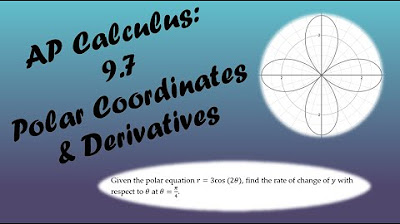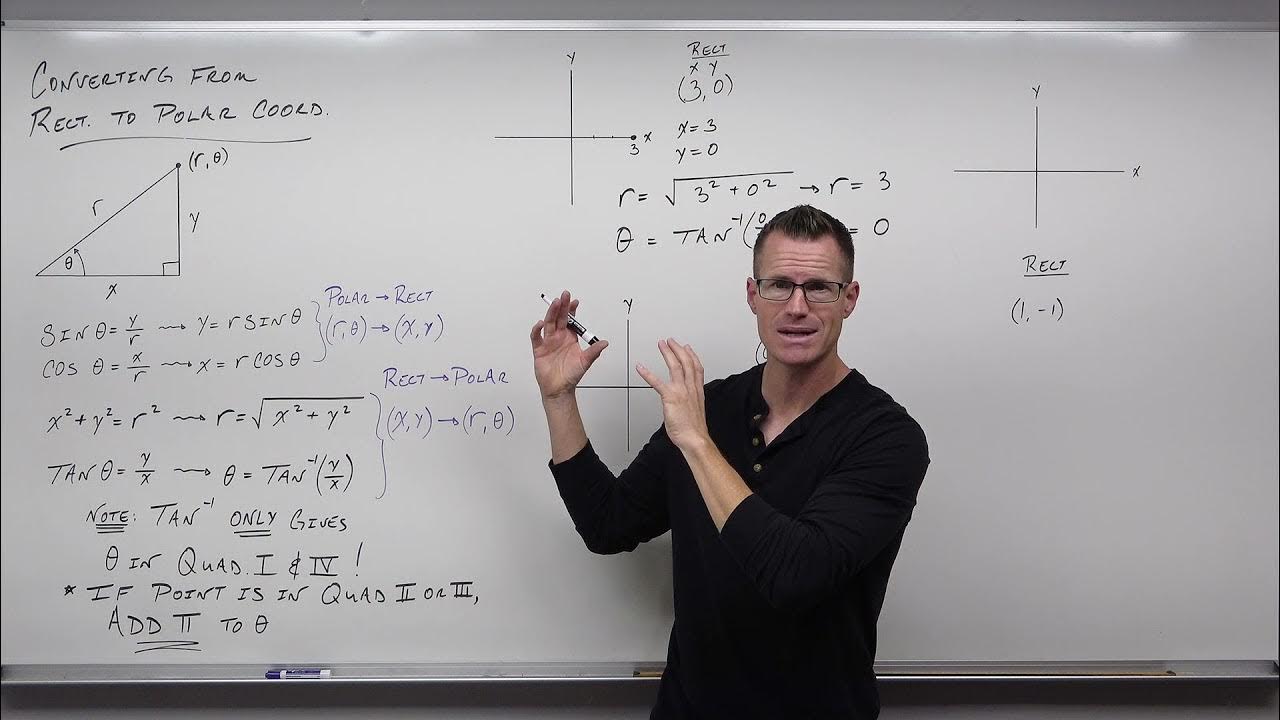Polar Coordinates and Polar Graphs
TLDRThis educational video script introduces the concepts of polar coordinates, explaining how to graph them and convert between polar and rectangular coordinates. It demonstrates graphing with positive and negative radii and angles, and covers the formulas for converting between coordinate systems. The script also explores converting equations to polar form and finding the slope in polar coordinates, providing step-by-step examples to aid understanding.
Takeaways
- 📚 Polar coordinates are represented as \( R, \theta \) where \( R \) is the distance from the origin and \( \theta \) is the angle of rotation from the positive x-axis.
- 📐 To graph polar coordinates, move out to the specified circle (counting from the origin) and rotate to the specified angle.
- 🔄 Negative radius values reflect the point in the opposite direction of the positive radius.
- ⏱ Negative angles indicate a clockwise rotation from the positive x-axis.
- 🔗 Conversion formulas between rectangular (x, y) and polar coordinates include \( x = R \cos(\theta) \) and \( y = R \sin(\theta) \).
- 🔄 The tangent of \( \theta \) can be used to find the angle when given x and y values, with \( \tan(\theta) = \frac{y}{x} \).
- 🔢 The Pythagorean theorem is used to find the radius \( R \) in polar coordinates, where \( R = \sqrt{x^2 + y^2} \).
- 📈 The equation \( y = R \sin(\theta) \) can be used to convert a horizontal line in rectangular coordinates to polar form.
- 🔴 The equation \( R = 5 \) represents a circle with a radius of 5 in polar coordinates.
- 📊 The equation \( R = 2 \cos(\theta) \) represents a circle with a radius of 1, shifted to the right in polar coordinates.
- 📉 The equation \( \theta = \frac{2\pi}{3} \) can be converted to a line equation in rectangular coordinates by using the tangent function, resulting in \( y = -\sqrt{3}x \).
Q & A
What is the basic representation of polar coordinates?
-Polar coordinates are represented as (R, θ), where R is the distance from the origin (also known as the radius) and θ is the angle of rotation from the positive x-axis.
How do you graph a polar coordinate with a positive radius?
-To graph a polar coordinate with a positive radius, you move out to the corresponding circle number (R) and then rotate to the specified angle (θ) from the positive x-axis.
What does a negative radius in polar coordinates indicate?
-A negative radius in polar coordinates indicates that the point is reflected in the opposite direction along the radial line corresponding to the angle θ.
How do you graph a polar coordinate with a negative angle?
-A negative angle in polar coordinates means you rotate clockwise from the positive x-axis to the specified angle. The radius remains the same in magnitude but is drawn in the clockwise direction.
What is the formula to convert from polar to rectangular coordinates using cosine?
-The formula to convert from polar to rectangular coordinates using cosine is x = R * cos(θ).
How do you convert from polar to rectangular coordinates using sine?
-The formula to convert from polar to rectangular coordinates using sine is y = R * sin(θ).
What is the relationship between the tangent of an angle and the rectangular coordinates?
-The tangent of an angle θ is equal to the ratio of the y-coordinate to the x-coordinate, or tan(θ) = y/x.
How do you find the polar coordinate R given rectangular coordinates (x, y)?
-You can find the polar coordinate R by using the Pythagorean theorem: R = √(x² + y²).
What is the polar form of the equation for a horizontal line at y = 4?
-The polar form of the equation for a horizontal line at y = 4 is R = 4 / sin(θ), which can also be written as R = 4 / cosecant(θ).
How do you convert the rectangular equation x² + y² = 25 into polar form?
-In polar form, the equation x² + y² = 25 becomes R² = 25, which simplifies to R = 5.
What is the process for converting the equation R = 2cos(θ) into rectangular form?
-To convert R = 2cos(θ) into rectangular form, you first express x in terms of θ as x = R * cos(θ), and then solve for R² in terms of x: R² = 2x, which leads to x² + y² = 2x after substituting y = R * sin(θ).
How do you find the slope of a curve in polar coordinates?
-To find the slope of a curve in polar coordinates, you take the derivative of y with respect to θ (dy/dθ) and divide it by the derivative of x with respect to θ (dx/dθ), which is dy/dθ / dx/dθ.
What is the slope of the line represented by the equation y = -√3 * x?
-The slope of the line represented by the equation y = -√3 * x is -√3.
Outlines
📚 Introduction to Polar Coordinates
This paragraph introduces the concept of polar coordinates, explaining the basic components of R (radius) and θ (angle of rotation from the positive x-axis). It demonstrates how to graph polar coordinates by providing examples, such as graphing at the fourth circle with a 2π/3 rotation and at the third circle with a 7π/6 rotation. Negative radius and angles are also discussed, showing how they affect the graphing process. The paragraph lays the groundwork for understanding polar coordinates and their graphical representation.
🔍 Conversion Between Rectangular and Polar Coordinates
This section delves into the conversion formulas between rectangular (x, y) and polar (R, θ) coordinates. It explains the relationships using trigonometric functions: x = R * cos(θ) and y = R * sin(θ), which are used to convert from polar to rectangular coordinates. It also discusses the reverse conversion using the Pythagorean theorem, R² = x² + y², to find the radius R. Examples are provided to illustrate the conversion process, including converting a polar coordinate to rectangular and vice versa, with a focus on understanding the mathematical relationships between the two coordinate systems.
📈 Graphing Polar Equations and Understanding Slopes
The final paragraph discusses the process of graphing polar equations, starting with the conversion of a horizontal line equation (y = 4) into its polar form, R = 4 / sin(θ), which is also expressed as R = 4 / cosecant(θ). It then covers the graphing of a circle with a radius of 5 in polar coordinates, simply as R = 5. The paragraph continues with the conversion of equations involving sine and cosine into their polar forms, explaining how to identify and graph lines with specific slopes in polar coordinates. It concludes with a brief introduction to finding slopes in polar coordinates by taking derivatives, using the chain rule to express dy/dx in terms of dθ, and provides an example calculation for a specific angle, θ = π/6.
Mindmap
Keywords
💡Polar Coordinates
💡Rectangular Coordinates
💡Graphing
💡Radians
💡Negative Radius
💡Conversion Formulas
💡Pythagorean Theorem
💡Tangent
💡Slope
💡Derivative
💡Horizontal Line
💡Circle Equation
Highlights
Introduction to polar coordinates and their graphing.
Explanation of polar coordinates with R and theta.
Demonstration of graphing polar coordinates with R = 4 and θ = 2π/3.
Graphing with a negative radius and its implications.
Understanding negative angles and their effect on graphing.
Conversion formulas between rectangular and polar coordinates.
Conversion example from polar to rectangular coordinates.
Conversion from rectangular to polar coordinates using the Pythagorean theorem.
Conversion of the equation y = 4 to polar form.
Equation of a circle in polar coordinates with radius 5.
Conversion of sine theta = 3 to rectangular form.
Conversion of R = 2 cos theta to rectangular form and graphing.
Graphing the equation θ = 2π/3 in polar coordinates.
Calculating slope in polar coordinates using derivatives.
Derivative example for calculating slope in polar coordinates.
Evaluation of dy/dx at θ = π/6 and its verification.
Transcripts
Browse More Related Video

Calculus 2: Polar Coordinates (Video #30) | Math with Professor V

Polar Coordinates Basic Introduction, Conversion to Rectangular, How to Plot Points, Negative R Valu

Precalculus: Polar Coordinates (Section 9.1) | Math with Professor V

AP Calculus BC Lesson 9.7

How to Convert From Rectangular Coordinates to Polar Coordinates (Precalculus - Trigonometry 38)

Ch. 8.1 Polar Coordinates
5.0 / 5 (0 votes)
Thanks for rating: